Contemplative Cuties - The Creatures of Maiko Kobayashi
An interview with Maiko Kobayashi
© Maiko Kobayashi
Endearingly ambiguous yet piercingly poignant, the amorphous creatures of Tokyo-based artist Maiko Kobayashi will make you feel undeniably human. Kobayashi’s art style is an intimate expression of a universally resonant vulnerability developed throughout her career of over 20 years. Variations of adorably pensive creatures, often resembling a cartoonish dog, rabbit, or something in-between, have fueled Kobayashi’s success.
At first glance, the creatures appear deceptively simple. A minimalistic body — usually white or beige — two eyes, a round nose, sometimes a mouth. However, the simplicity of Kobayashi’s creatures amplifies the depth of her message by creating space for viewers to populate with their own reflections and feelings. The teetering vagueness of the creatures’ physical forms, facial expressions, and human-ness is what makes Kobayashi’s art so evocative. As prominent Japanese writer Jun'ichirō Tanizaki famously wrote, “And isn't it better really to leave things only hinted at?” Kobayashi doesn’t confine the perceptions of viewers with an explicit story or explanation. The solution of this “third creature” weaves through the limited preconceptions of human and animal, charting a course to directly reach the heart. Without the stifling entrapment of certainty, there is room to connect.
Despite the vague humanity of Maiko Kobayashi’s creatures, the human spirit is absolutely central to her work. Kobayashi meticulously handcrafts her creations to follow the force that motivates her art: the palpable juxtaposition between helplessness and the indomitable human vitality.
“The more I get to know things in the world, the more often I feel helpless. But, when I discover that human beings have that essential vitality that will never be lost under any circumstances, my heart fills with courage and hope. The “friction” caused by this contradictory sensation is my motivation to draw.” - Kobayashi

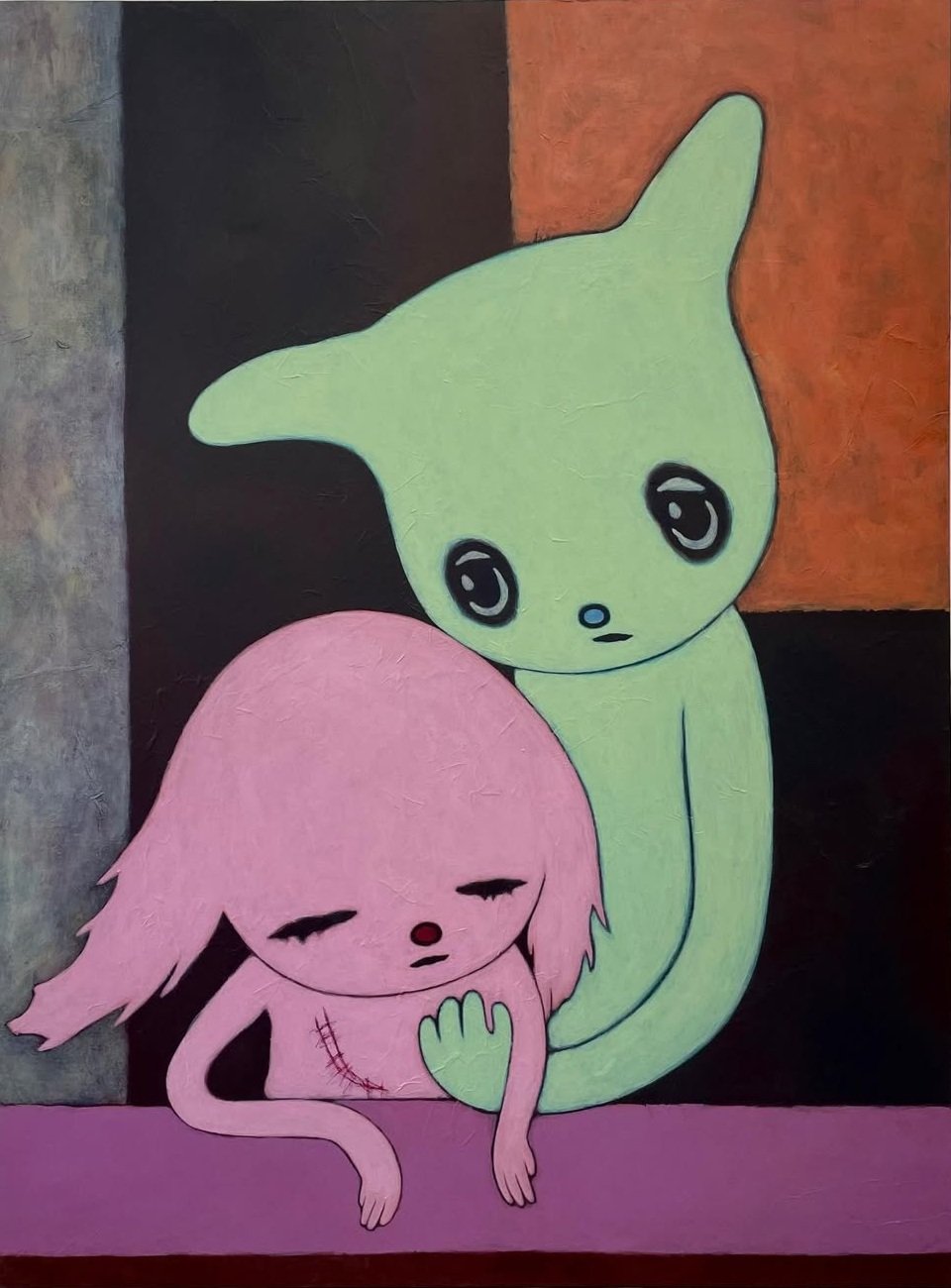




The Yokohama-City-born artist grew up in Sagamihara City, Kanagawa, before relocating to Machida City, Tokyo, prior to entering junior high school. She began her art education at The Junior College of Musashino Art University in 1995. In her twenties, Kobayashi began to develop her enduring signature style of minimalistic, ambiguous creatures. In 2008, she continued her art education at Northumbria University in England, where her unique art style garnered attention for the healing emotions it evoked.
While Kobayashi’s art has been linked to the common, overarching human experience, her work is simultaneously deeply personal. The artist refers to her famous creatures as her own “alter-egos,” presented in a universally understood format. Each feeling, thought, and mood she portrays is composed with incredible intentionality: she patiently layers acrylics, oil pastels, and colored pencils to build depth that captures beyond the two dimensions of her canvas. Kobayashi’s painting process allows her to look into the core of her unraveling emotions through multiple perspectives, surfacing themes of inner change in her work.
“When I paint, the creatures in the painting connect with my inner feelings and thoughts, and as if guided by them, I place the colors and lines that come to mind on the canvas.” - Kobayashi
Kobayashi paintings are not a snapshot taken in one fell swoop. They are the product of a rich, steadily developed expression. Instinctive lines and intuitive phrases are drawn and erased in a repetitive ritual, creating strata of texture and color teeming with life-force energy. The product? Complex and contemplative creatures brimming with the accumulated vitality of the painted-over apparitions.
Sometimes, the depth of Kobayashi’s work is not immediately overt. But often, we can gain a glimpse into the depth of Kobayashi’s work through her creature’s dreamy doe eyes. Vibrant rings of deeply pigmented colors form a piercing, colorful gaze. They shimmer like stars in the center of an amorphous, fluid nebula. Whether immediately visible or not, this immense level of care is consistent in each of the artist’s creative endeavors.
Maiko Kobayashi’s intentionality touches every aspect of her work, including the washi paper upon which she’s been capturing her creatures since 2015. According to the artist, washi paper is a lot like human vitality: thin, tough, fragile, and millennia-enduring.

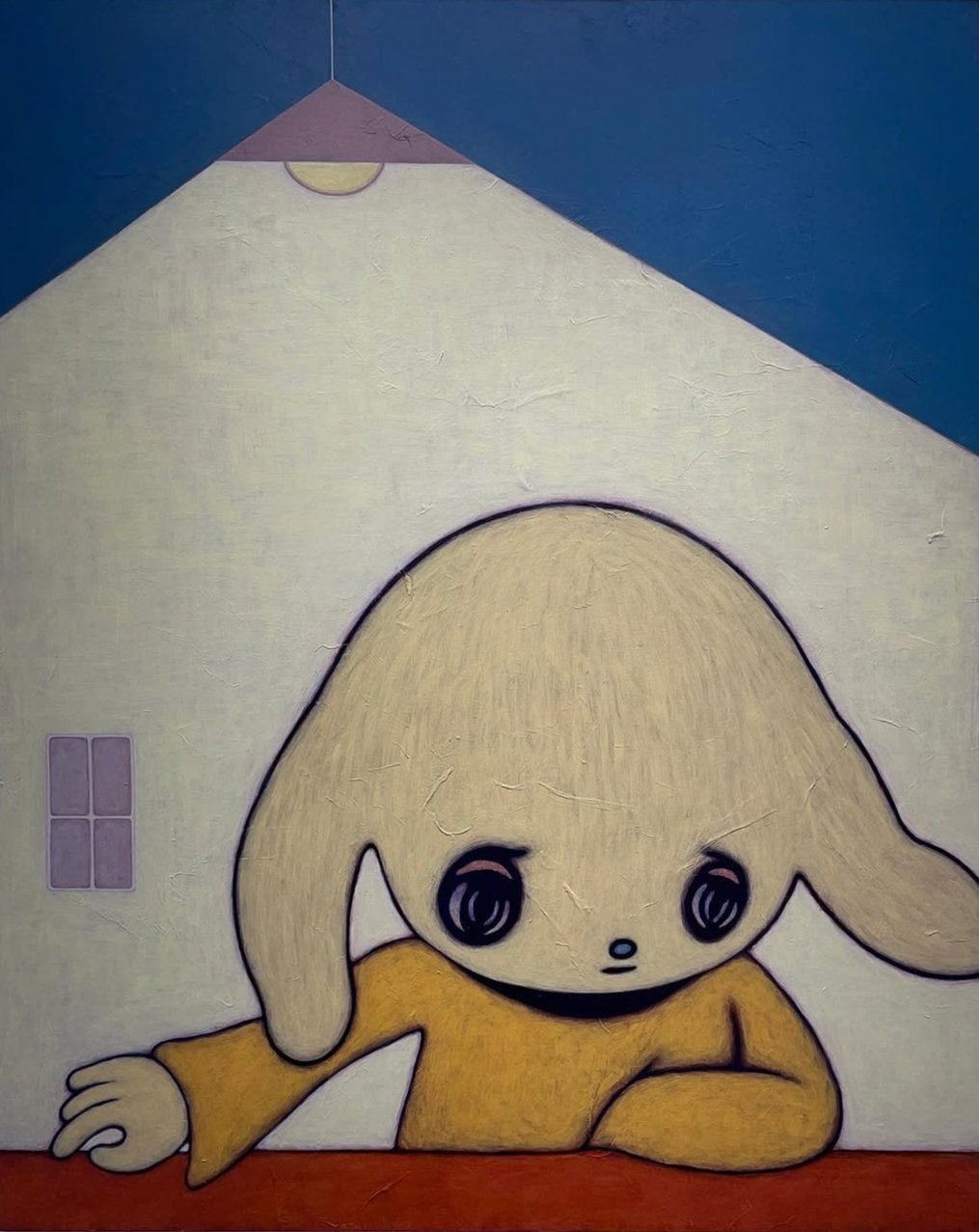
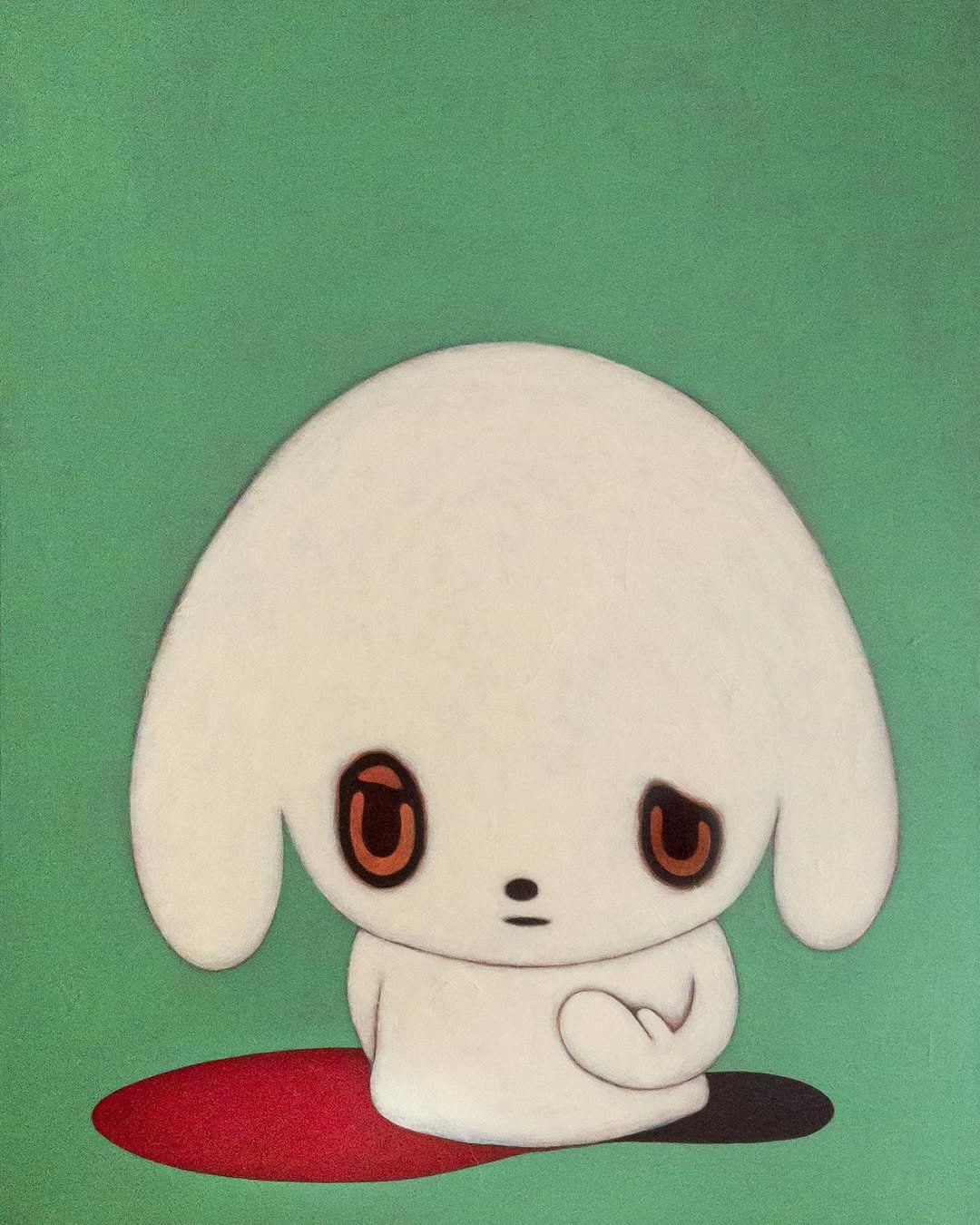
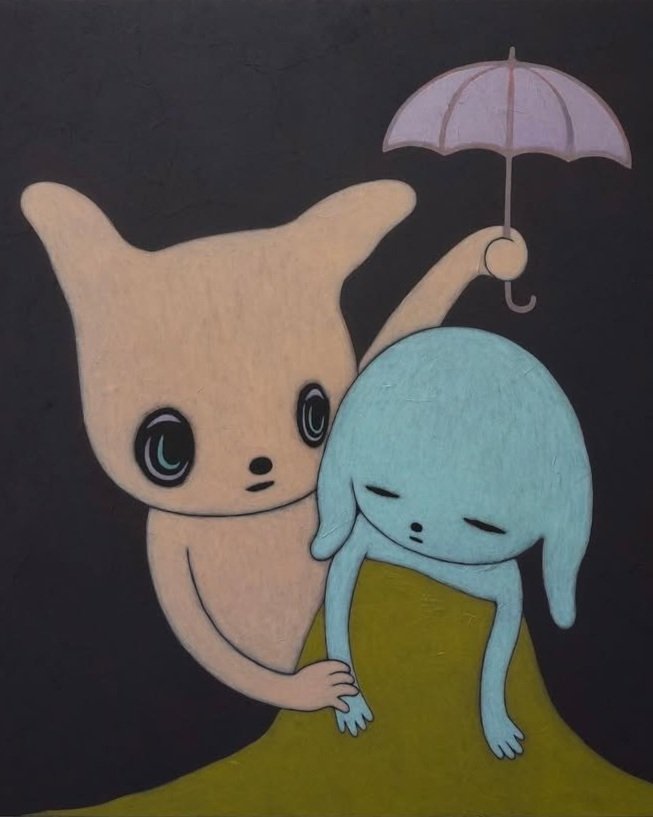


I had the privilege to chat with Maiko Kobayashi herself, and I couldn’t be more thrilled to share her insights with you. Read our interview to learn more about the origins of Kobayashi’s brimming emotions, the philosophy anchoring her creative process, and her message to the viewers who share a moment to contemplate these emotion-imbued characters with her.
Your painting process goes through several revisions. What is your thought process while you paint, and at what point do you decide that an artwork is finished?
From the beginning of my artistic career to my 30s, a single painting would be revised several times, with the shapes and colors of the creatures changing continuously. It is as if there are several layers of different pictures within a single painting. My approach was based on the idea of capturing my own shifting emotions and thoughts on canvas at any given time. Still, as my career has progressed, my thought process in approaching the subject of my paintings has become more apparent, and I have made fewer bold revisions in the past few years.
When painting on canvas, the process varies slightly depending on the canvas size. For smaller canvases, I pick up the image of the creature that comes to mind while facing the canvas. I do a rough sketch before painting on canvas above middle-sized (one side is over 50 cm). The size of the canvas is one of the essential elements that make up the existence and environment of the creatures I draw. The same applies to paper in drawing.
When I paint, the creatures in the painting connect with my inner feelings and thoughts, and as if guided by them, I place the colors and lines that come to mind on the canvas. Typically, my creative process is a repetition of this method. Since there is no image of the finished picture from the beginning, I face all the elements that appear on the canvas in front of me and consciously or intuitively grasp the next color or line to be placed, and the subject of the painting becomes clear in the process.
During my creative process, I often use oil pastels or colored pencils to dab lines or words on the canvas, or wipe off the paint with a cloth. I hope that by accumulating layers of these traces and paints, the painting will contain some energy, like a life force.
In terms of creating the creatures, I make minute adjustments until the very end of the process so that the expressions and figures of the creatures reflect the various emotions that arise from the dialogue with the screen during the production process.
For me, painting is more like creating a two-dimensional object called a picture using paint rather than applying paint to create a picture. This is because I view the brushstrokes, scratching, wiping, and other painting actions as something similar to using clay to create a three-dimensional work of art.
As for deciding when a work is completed - sometimes I can tell there is no need to paint anymore, and other times it is not so clear. However, when I look at a painting, if I feel that the creatures in the painting are speaking to me, or if each canvas expresses the best I can do at the time, I let go of the painting and think of it as completed for the moment.
The layers in your paintings seem to portray an emotional journey. As you paint, are you digging back to uncover the root of an emotion, or are you discovering new emotions that emerge while you work?
Yes, as I mentioned above, the layers of my paintings are certainly “emotional journeys.” When I am painting, rather than delving into where those emotions came from, there are already events or things that I was concerned about (whether these are personal or social) that triggered those emotions. As I carry them inside me while painting, my thoughts and perspectives about them deepen from multiple perspectives, and the feelings I initially had about them begin to change. I believe that this process of inner change is reflected in my paintings.
I read that you consider your creatures to be your own “alter-ego.” How do sources of inspiration from different stages of your life reflect in your work?
I think my sources of inspiration are mainly reflected in the changes in the creature’s form. I started drawing these creatures around 2000, but at the time, I had no idea that I would publish them. At the time, I was letting go of the frustration and anxiety about the future, dissatisfaction with the environment that surrounded me, and anger at society that only a young person can have. I would draw from these energies and put pencil or pen to paper. At first, the shapes were varied: characters with only a face, or a long face, or an unusually large head, or with hair. (Even now, they are not always constant). I did not want to draw something recognizably human, but I needed to create a third creature that was neither a specific human being nor an animal but something I could feel close to ― something that would speak on my behalf. I needed to create a third creature. This was the beginning of everything.
Also, since the source of inspiration for my paintings arises from inside me, I think my human growth and the growth (change) of my paintings are proceeding simultaneously. I have seen various changes in the facial structure and size of the creatures; some have arms and legs, some wear clothes, and the colors used in my paintings have changed from monochromatic to multicolored, but the changes in my awareness of and attitude toward expression, as well as the changes in my inner self, have been the most important factors in my paintings at any given time. I believe that the changes in my awareness of and attitude toward expression, as well as my internal changes, are honestly reflected in the paintings of each period.


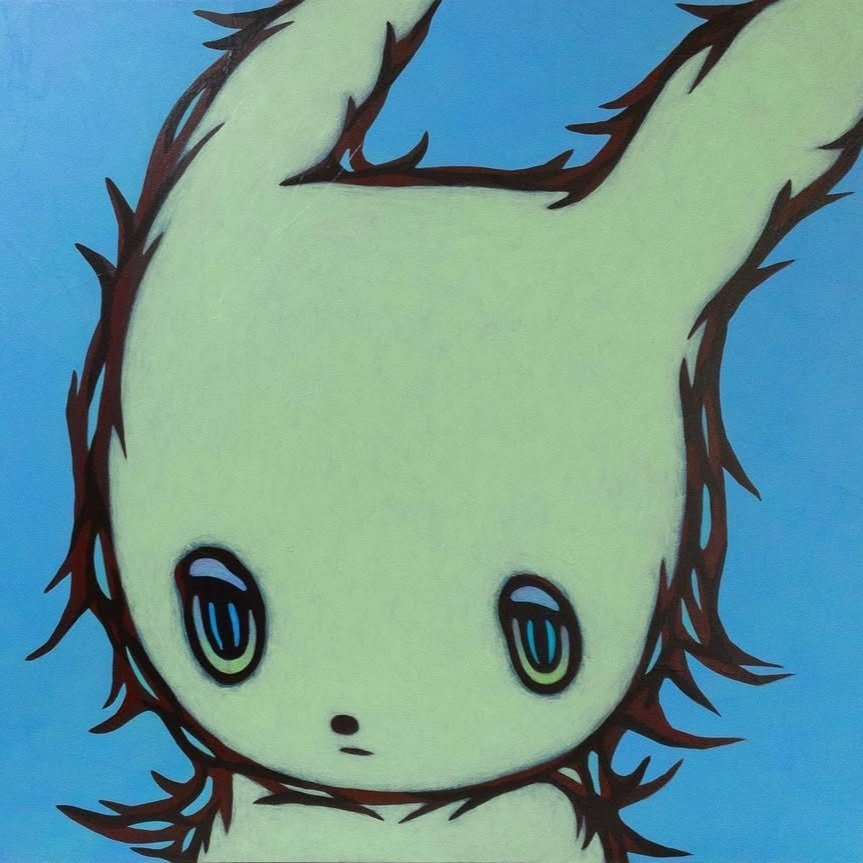


What do you hope viewers feel when they look at your work?
Frankly speaking, I believe that if the viewer sees my work as they feel it, that is all that matters. For example, if the viewer does not feel anything when looking at my painting, it may be that there is a problem with my work, that I do not have enough energy to appeal to them, or that we are not compatible (just like when we meet people).
When you look at my work, I don’t really want you to feel a particular emotion from me (the artist’s side) to the viewer. The purpose of my work is not to convey in concrete terms the strong emotions or certain feelings I have when I paint. It is essential that they ultimately become the energy of the work. I am interested in stimulating the viewer’s imagination with my work and how far I can extend that imaginary world.
People who view my paintings often say, “It’s like having an experience that brings me face to face with my inner self.” It is a great pleasure for me to be able to communicate with my paintings in this way.
While studying in England, a local artist once told me, “they are like ‘special friends’' to you.” I realized that I often talked to these creatures during the painting process. It would be wonderful if they could also be like friends to the viewers.








Fatbeard’s pixel art captures Japan’s timeless beauty in modern form.